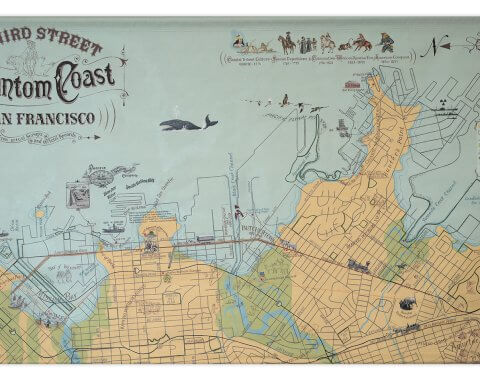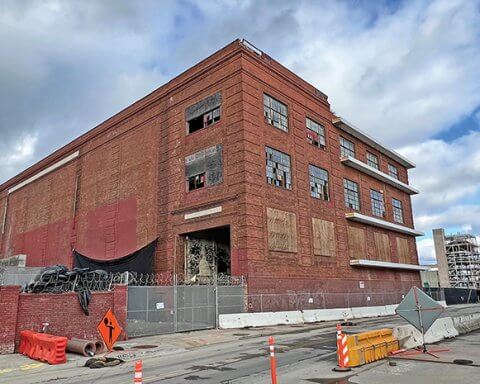David Maron was named captain of the Bayview Station last February, after more than 25 years with the San Francisco Police Department. His appointment was made in the wake of a year of civic unrest demanding changes to policing and public safety nationwide.
Maron was previously a lieutenant at Park Station on the Westside for three years after being a patrol sergeant and station investigator at the Ingleside Station for five years and serving 10 years in the tactical unit. He got his start at Southern, Northern and Mission stations.
When asked if morale has been affected by anti-police sentiments, Maron said “I think it would depend on where you’re at. Here in Bayview, morale is pretty good. A lot of people – including myself – love to come to work, enjoy this job. Now that may change if you’re talking to someone else, but I love connecting to work, and interacting with the officers and the community.”
Maron’s approach to patrolling remains consistent. “In general, we’re doing what we’ve always done,” he said. “We try to be fair.”
As the View reported last month, crime has declined in District 10 – which includes Potrero Hill, Dogpatch, Bayview-Hunters Point and Visitacion Valley – over the last four years, including from 2020 to 2021. Maron confirmed that trend, in spite of perceptions and a shortage of officers.
“We move officers around to fill the needs of the community, but we’re short,” Maron said. “Numbers wise, Bayview has 111 police assigned.”
Maron said he’s “not sure” how many officers Bayview station should have, “but we are down compared to where we were several years ago.”
According to Maron, when a station loses officers, foot and bike patrols go first – even though those activities are popular with the public – because vehicle patrols are most responsive to an emergency situation.
“When we start losing officers, we have to be sure we have adequate numbers in the sector cars, so we have to pull from the bike beats,” Maron said, noting that SFPD is recruiting, sometimes finding officers “as far out as Chicago and New York.”
Matt Dorsey, SFPD’s director of strategic communications, said that staffing shortages may worsen as officers like Maron – who joined the force during a hiring spree that created the so-called ‘Clinton cohort’ in the mid-1990s – retire.
According to a 2020 Matrix Consulting Group report on police staffing, “another 134 officer positions are needed to staff patrol at a level that is able to consistently be able to handle incoming workloads” and reach proactivity goals. At the time the report was issued there were 691 sector patrol officers.
The Reverend Raynard H. Hillis, of the San Francisco African American Faith Based Coalition, takes an expansive view of what it means to foster public safety that goes beyond issues the police can address.
“Like many other cities, some neighborhoods are rougher than others,” said Hillis, Coalition co-chair and pastor at the Double Rock Baptist Church in Bayview. Bayview residents “…don’t consider themselves in a safe environment, and that’s what I consider when it comes to safety. The job market has not improved and whenever there’s an issue of no jobs, no housing, education not meeting the needs of people, you’re going to have an unsafe environment.”
According to Hillis, under his definition public safety in District 10 is worse than it was a year ago, with too little economic investment in the Black community.
Hillis said that law enforcement is necessary but “there’s no community policing. When people started to cry ‘defund the police,’ I think we needed a clearer picture. African American leaders thought reform would be a better slogan than defund because most of us understand we need competent policing. The problem is there’s no community policing. So you ask people, men and women, to serve our community but they don’t know about us, about our culture.”
Hillis said that police officers should reach out to everyone from pastors to business owners to ask about their blocks and communities. For example, he said, community leaders can tell constables if someone who lives in the neighborhood has a mental issue that may cause them to behave erratically or dangerously.
“Learn about the hot spots,” Hillis said. “Community people can offer to be of help and support before it becomes an issue. I don’t think police will ever be policing our community until they learn our community. Police officers have to make life and death decisions in the blink of an eye. They can’t be getting ideology from TV and other forms of media.”
According to Maron, who is the son of Canadian and Filipina immigrants, “we do community engagement every single day. We’re walking foot beats; we’re really engaging with the community,” adding that officers distribute flyers about such issues as proper behavior in traffic and stopping burglaries. Maron holds a public video meeting the first Tuesday of each month.
Hillis believes that police should not be asked to deal with “mental health issues” that aren’t in their competence.
According to Maron, the Street Crisis Response Team, an initiative launched last year, is responsible for responding to a nonviolent person having a mental health crisis on the street. Street crisis response teams are dispatched in response to 911 calls that don’t require a police presence.
In spite of the officer shortage, Mayor London Breed and District 10 Supervisor Shamann Walton have made good on their promise to divert police funding to the Black community. Earlier this year, Breed announced a plan to redirect $120 million over the next two years. The largest portion of that this year — $15 million — was spent on community health and wellness initiatives.
“I agree completely,” Hillis said. “I still have a problem with certain equipment the police are spending so much money on. It’s not like we’re in the Vietnam War. Do I have hope it’s gotten better? No. Do I hope it will? I do.”



